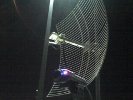|
While it may function it is not the ideal deployment.
MIMO (multiple input multiple output) devices really want to see the same input on all antennas and will chooses the stronger of the two signals.
They seem to work best when running in different polarities (H+V) or at least separated a distance apart from each other (the point is to get a different reflection to one antenna vs another)
In the case of 802.11n devices they actually use the fact that different polarities can be used (30+db isolation between polarities) to allow 2 data streams over the exact same frequency when the channel is useable, and when its not it falls back to 1x2 (1 chain 2 antennas) to cover the fact that one single path may be stronger (at any given second)
2x devices would be better (one on the Omni and one on the directional) and use DTDLINK to link the nodes together, Especially if you use dual polarity on the directional and the Omni.
Signals can change polarity as they bounce , Vertical is the usually noiser polarity. A signal from a field node may leave vertically and end up Horizontal on the other end, or horizontal and end up vertical, or maintain its polarity the entire trip.
Transmitting both polarities gives best chance for decodes at the other end. (Many of the Ubiquiti devices do this already) |
